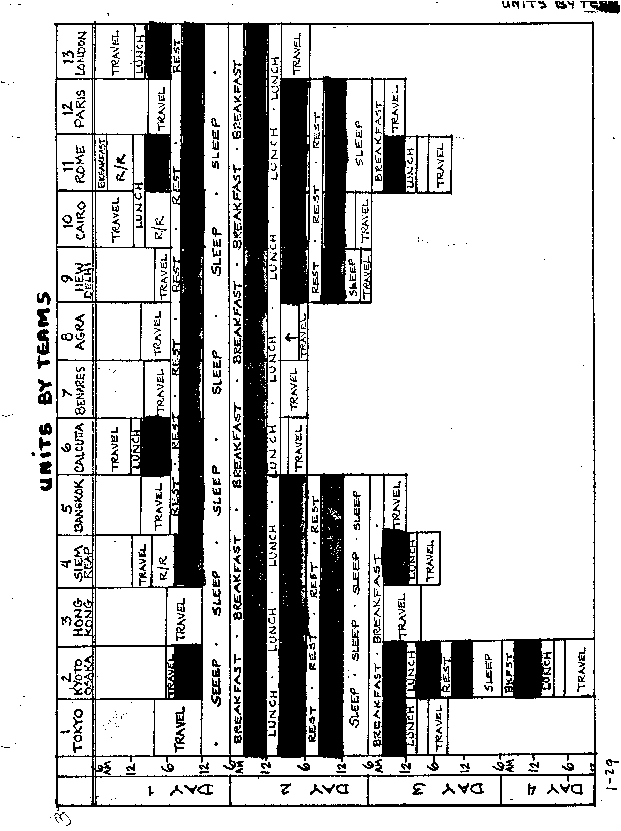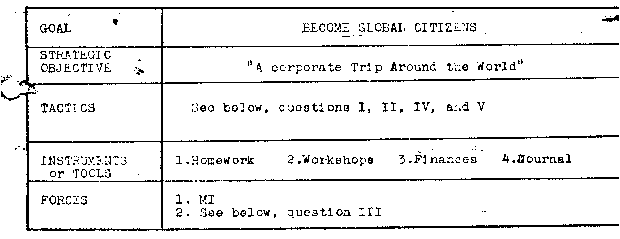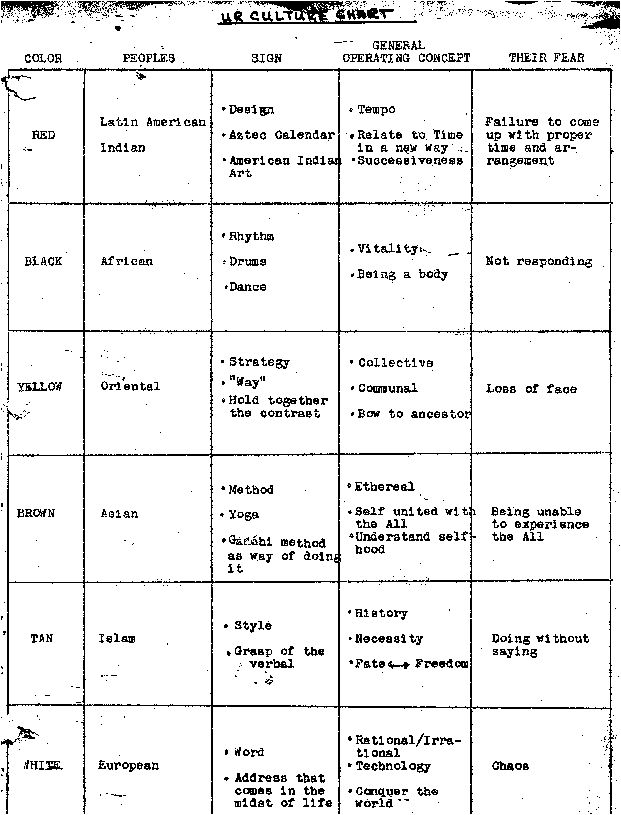
GLOBAL ODYSSEY
MY JOURNEY
Kyoto, an ancient capital of Japan, is a living museum of the culture of a people for 1000 years. The Ryoanji Temple, in Kyoto, has on its grounds a rock garden within a rectangular plot of sand. Our group went as a body to see the garden, made of sand, rocks, and a little moss, with a wall surrounding the garden.
The sand, raked each day in a special way with a tyned rake. serves as the bed for the garden. The rocks, arranged in groups of seven, five, and three, arranged in an asymetrical fashion, is surrounded by moss. The muted colors of the rocks were of the earth: greys, browns, bluish greens. The occasion was a warm. still, humid day. Our group sat on the steps of the temple, in our bare feet, and spoke quietly in informal conversation, trying to soak up the experience.
I was filled with awe and fascination, and I longed for absolute silence. I gradually realized that I was immersed in symbols, and particularly those of the deep dark realms of the spirit. The wall was mystery to me, made of clay and rape seed, 500 years old. The sand became the abyss; the rocks were forms that flowed out of and as a part of the abyss.
I also imagined the garden as a symbol of the earth, of the affirmation of what is, of relationships; then I thought of the story of the creation, and then of man's involvement in the creative process.
Taking a second reflection, I began to see that garden as a transparent symbol that enables a human to find an oasis, or a moment of discontinuity, in his life. The Rock Garden could be a symbol for symbols themselves. It can serve as the symbols for the contemplative life. It served as a symbol for The Far East for me.
I detected in our group a hanging back, a lingering. It occurred to me that the whole universe is looking for selfconsciousness in the religious dimension of life.
In Calcutta, the legendary city of India, we were hotelled in The Grand, where 1000 workers were digging a swimming pool by hand; where 100 men were on their hands and knees day and nite scrubbing the marble floors; where 25 crippled children stood at the entrance and begged, hanging on our arms. As we went through the lobby and on to the dining room, we heard the orchestra playing Glenn Miller music, drowning out the parades of protectors with Red Flags marching in the streets. After lunch as we found our rooms we could see through the windows people living on the sidewalks, urinating on the curbs, sitting in a crouched position, a~4sleeping.
A Roman Catholic priest, Brother Andrew, came to our room to be interviewed by us. It was decided that he come to us, rather than we visit him, because of the danger of uprisings in the city following an attempted political assassination a few hours previous to that time.
What struck me was Brother Andrew's physical appearance, especially his posture. He was a lean, gaunt man, darkly dressed, who sat in a straight backed chair, alone in one section of the room. His shoulders were slumped, and his hands dropped between his knees. He looked up at us from a bowed head, and gazed at un through dark sorrowfilled eyes. In a quiet voice he described to us his work with the poor people of Calcutta, his life with his colleagues as they labor to meet immediate needs of the poorest of the poor. They work on a one to one basis, meeting the needs of food, medicine, clothing, and shelter. His despair evidenced in his conversation about the economic problems and the spirit problems impacted me.
I began to see a man who was physically dying, who was spiritually dying, whose work was dying. He was a personification of Calcutta to me; of the peoples of Calcutta; of death itself. What is it like to be gasping your last breaths? And I remembered the spiritual death I had experienced several years of my life. I thought of the tragedy, suffering, of the dying style of most of the peoples of the world. I saw the world dying for want of vocational structures of man.
Brother Andrew said he had been in contact with staff members of the Ecumenical Institute. I thought about his hearing of the Fifth City plan, and wondered what it would be like when he really appropriated the New Religious Mode with that New Social Vehicle for he was unconsciously asking for that part of the model. I wondered what his posture would be like if he were resurrected. I felt the imperative of being selfconsciously involved in the spirit movement in our time.
In Banaras, the sacred city of India, our group walked through the streets, the same ones that groups had walked through 2000 years ago. The streets were uneven, of clay and stone. Low houses and store fronts lined the narrow streets, made only for walking. Shopkeepers sat on the edge of the elevated stores, and some called out to entice us to buy. There were smells of incense, sights of food being fried in front of us, sounds of children begging us as they followed us on our walk, dogs yipping at our heels.
There were small dark alcoves along the way, and as I paused to look in one, I saw ten children sitting in a rough circle, being schooled. As I looked, two other children with books under their arms approached the semialleyway.
The experience of the walk was intensified as we entered one shop to get souvenirs. While there, bartering and jostling with people, beggars grabbing at our elbows, I missed Kay, our daughter. I became frightened, for I knew that if the stepped away from our group she could be swallowed up by the crowds, or disappear in one of the dark alcoves. After some minutes' search we located her in the rest room!
A little black haired girl with dancing eyes begged me for money during the entire walk. I thought of our children at home who were her age, and wondered if they would be begging had they been born in Banaras. I thought of JWM saying that to be in the Order was to be a beggar. I was offended, and wondered how one became a joyful beggar.
Banaras streets held all of the history of man for me, from 2000 years ago to the present to the next 2000 years. I thought of the drama of mankind; of the pushing, bartering, struggling, flirting, rubbing shoulders. And I thought of myself in that history, struggling and losing some of myself in that struggle.
Directly from Calcutta, from Death, we came upon Life and Joy in Agra by seeing the Taj, a mausoleum erected by Emperor Shah Jahan Mahal, in memory of his wife. Our entire group motored to the Taj to see it in the late afternoon. Weary of being in that crowd and of the guide, I walked down the open entrance about 20 feet back of the group. Other members, plus the guide constantly came back and addressed me. Determined to appropriate the monument, I arose before dawn the next morning and taxied along to see the Taj at sunrise. I could see the reflection of it in a pool that divided twin walkways to the terraced monument. The marble structure is inlaid with semi precious stones. Marble lattice work creates designs on the floor when the sun filters rays through.
Walking barefoot away from the Taj, I was struck by the symbolism of femininity expressed in the monument. I began to think of the woman, of her contrasts with the male, of the relationship of the woman to the man in our day, of the stages in the female revolution and of the male revolution. I thought about the men on our trip, and of the crying need for the male to break through the tyranny of the economic dimension, of the tyranny of the wife and of the children in the family.
Seeing the solitariness of the structure triggered my thinking about the solitary; the solitary individual performing a solitary act that takes years to perform. I thought about creating symbols for love. What would such a symbol be today? What would a symbol be for the most intimate of relationships?
I thought about beauty and
joy in the midst of chaos and death; how it is deliberately planned for
an expression of a human dimension of life, knowing it is on the other
side of death.
 |
 |
MI WORKSHOP: August
7, 1969:
I. In order to be intentional and comprehensive, what countries or cities are critical to our trip?
5 primary 5 secondary
II. What time of the year
would it be best, or most possible, f'or you to be gone for three weeks?
III. Should this trip be open to other groups or individuals?
3 reasons, why:
3 reasons why not:
IV. How would you structure this group's penetration of each country in order to find out what is going on concretely?
POLITICALLY:
CULTURALLY:
ECONOMICALLY:
V. What would be your 5 point program, to include in a Journal, for getting the following images on each country:
BROAD PICTURE:
STRUGGLE:
FUTURE:
 |